
Visit Shrines
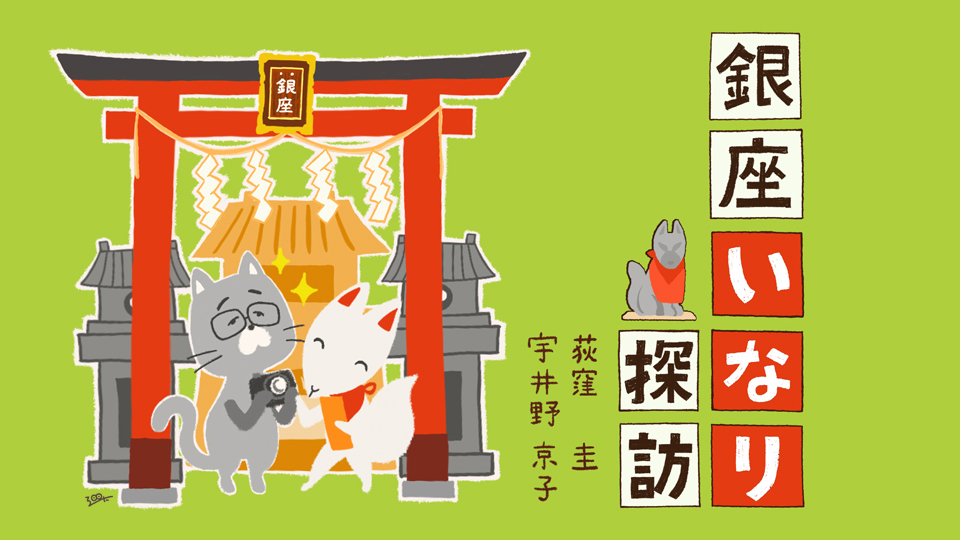
Visit Ginza’s Inari Shrines Vol.7 Ginza Inari in Ginza 2-chome
2021.08.01
The Inari Shrine to be visited this time is located in Ginza 2-chome. Since this is where the silver mint, or the “Ginza” was established, this Inari Shrine sits right in the Ginza of Ginza, where the town originated. Named after the silver mint, it is called Ginza Inari Shrine. Although it is normally closed to the public, we were granted a special opportunity to visit. Let us explore the shrine.

- Uino
- Today, we are going to visit THE Inari Shrine, or should I say THE Ginza Shrine.
- Ogikubo
- Ginza 2-chome is where Ginza originated. There is a stone on the sidewalk that says “Origin of Ginza.” Although it was built after World War II, it is written from right to left.
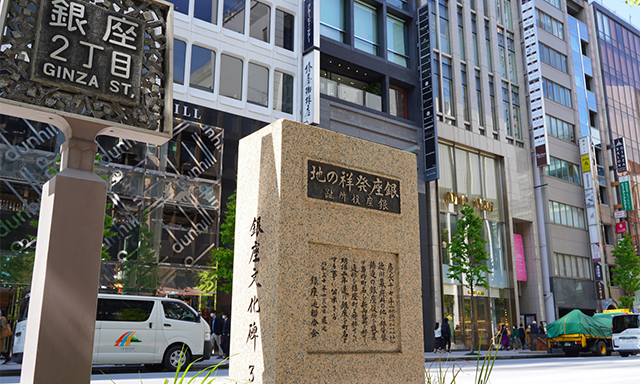
- Uino
- What does it say.
- Ogikubo
- It says, “Site of Ginza Yakusho. In 1612 (Keicho 17) the Tokugawa Shogunate established the Ginza Yakusho of the silver mint. The area had originally been named Shinryogae-cho, and was known by the name ‘Ginza-cho,’ but it was formally named Ginza in 1869 (Meiji 2).” If Ginza Yakusho had not been established here, all the commercial streets across Japan may not have been called “so and so Ginza.”
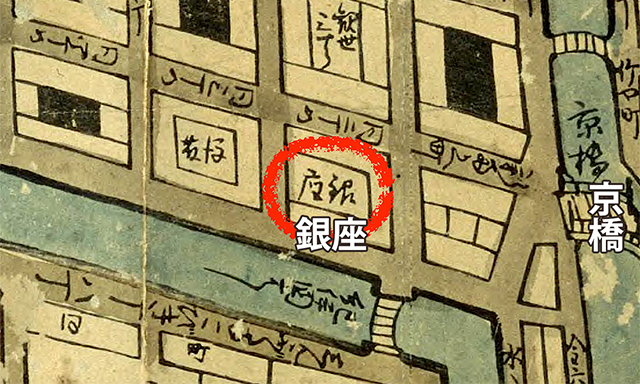
”Ginza” is marked on the map
”Bushu Toyoshima-gun Edo (sho)-zu” (National Diet Library collection)
- Uino
- So the name “Ginza,” with that lively ring spread from here. There is a kimono store, Ginza Echigoya, that has continued business around here since the Edo period. The Ginza Inari has close ties with Ginza Echigoya.
- Ogikubo
- That is a store with quite a long history. However, this street only has tall modern buildings and the name Echigoya is nowhere to be seen. Where in the world is it?
- Uino
- (laughs) Your reaction is just as I had expected. Echigoya is in that building over there (in the right-hand back of the monument marking the origin of Ginza).
- Ogikubo
- Really? It doesn’t look like an “Echigoya.”
- Uino
- What is an “Echigoya” supposed to look like? (laughs) Let us go around to the back of the building. If we proceed to Ginza Gasto Dori (Ginza Gas Lamp Street), one street beyond Chuo-dori, we will find ourselves on the other side of the building.
- Ogikubo
- So this is Ginza Echigoya.
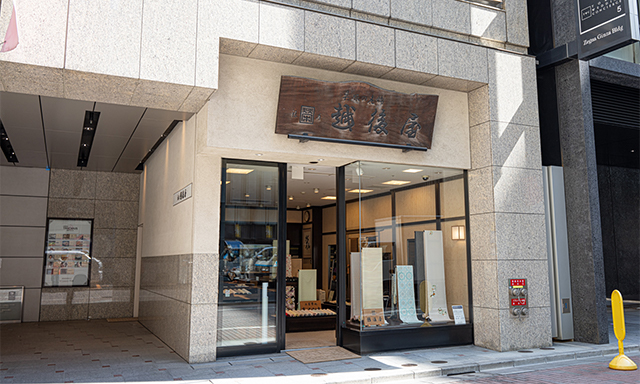
- Uino
- As I mentioned earlier, this is a time-honored kimono store.
- Ogikubo
- The Echigoya in Ginza that immediately pops up in my mind is Mitsukoshi, since it is short for Mitsui Echigoya. The name was taken after the founder Takatoshi Mitsui’s grandfather, who was Echigonokami (governor of Echigo province).
- Uino
- Ginza Echigoya was started by Chosuke Nagai, who had originally come to Edo from Echigo province (currently Niigata Prefecture) for an apprenticeship and later opened a indigo dye store in Kyobashi Tenma-cho in 1755. The store was named Echigoya, after his home province. Where was Kyobashi Tenma-cho located?
- Ogikubo
- The northern side of Kyobashi used to be called Minami Tenma-cho, so I would suppose it was around there. It is not so far away from the current store.
- Uino
- Nagai expanded his business to kimono retail and the store was moved here when it was run by its second-generation owner. Therefore, it is a long-established store continuing from the Edo period. Given its long history, it has many stories to tell, some of which can be read about in Vol. 21 of “Ginbura Hyakunen” on the Ginza Official website. The current building was completed in 2010, but before its renewal, the store was in an old building constructed in 1931 (Showa 6),
- Ogikubo
- Then let us look at a map of Ginza from around 1965 (Showa 40), just as we have come to do on every excursion. There it is – Echigoya Building.
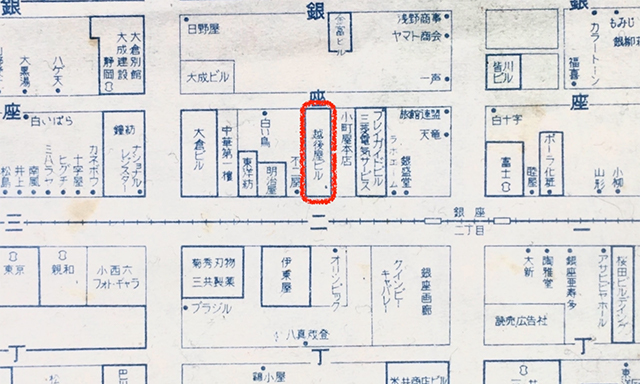
Echigoya Building can be found on the map.
- Uino
- It is quite impressive that they have continued their business for generations, modernizing their building with the times.
- Ogikubo
- Now that I know the story of Echigoya, can we go on to the story of Ginza Inari Shrine?
- Uino
- Yes. Ginza Inari Shrine is managed by Ginza Echigoya.
- Ogikubo
- Do you mean to say that Ginza Inari Shrine originally protected Echigoya’s land?
- Uino
- That is what I initially thought, too. However, Ginza Inari Shrine enshrines the deity that protects the Ginza 2-chome district. It is the Inari Shrine of central Ginza.
- Ogikubo
- Oh I see. Then it is a must see. Is the shrine close by?
- Uino
- Yes. It is located at this address, but it is usually closed to the public, because…
- Ogikubo
- Because?
- Uino
- It sits on the roof of the Ginza Echigoya Building. Although it is closed to the public, Ginza Echigoya has agreed to let us visit it. Let us take the elevator up to the roof.
- Ogikubo
- The door to the roof area says, “Ginza Inari Shrine.” Unlock the door, and it will open out to a space dedicated to the Inari Shrine. Amazing! A space reserved especially for the Inari Shrine.
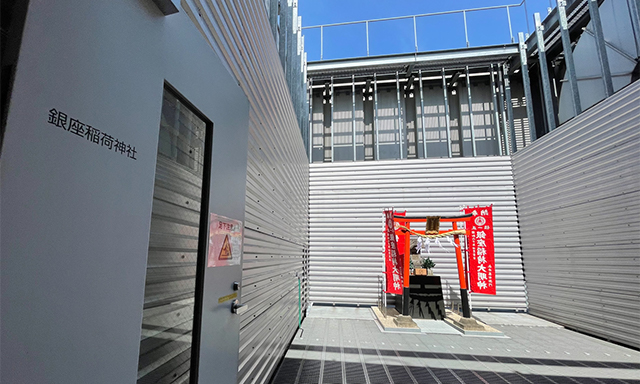
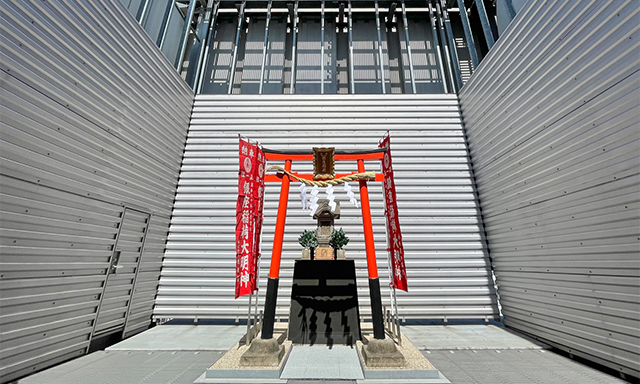
- Ogikubo
- We often see Inari Shrines on the roof of department stores and companies built in prayer for prosperity and fire prevention.
- Uino
- Although it is not a large shrine, the sight of it sitting in a very modern structure is quite impressive. My first impression was, “Wow! How cool.” The bright red stands out against the silver aluminum walls and almost looks like a scene from an SF movie.
- Ogikubo
- The building and torii gate look new, but the stone shrine looks like it may have a long history.
- Uino
- The stone shrine is very old. It originally sat in the backstreet, which disappeared when the area was re-developed after the war. The shrine was then moved to the Echigoya Building and refurbished in 2010, when the new building was constructed.
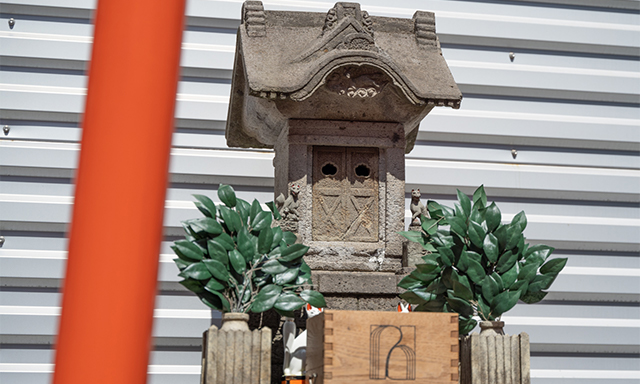
- Ogikubo
- It is very good to know that the old stone shrine has been preserved, despite all the development projects going on in the surrounding area. It is important that the deity that oversees the town is enshrined, even if it cannot be seen.
- Uino
- You are right. And the deity has indeed protected the town. In the recent Great Earthquake, a part of the shrine dropped from the pedestal, but the building was safe. Then owner of Echigoya said, “the Oinari deity protected us from the earthquake, by suffering the damage on our behalf.” Therefore, the story of the old local shrine that re-enshrined the Inari deity and the people who take care of it goes on.
- Ogikubo
- I guess the shrine is closed to the public because it is on the roof.
- Uino
- Unfortunately, it cannot be visited casually like the other Inari Shrines that we have visited. However, ujiko (patrons of a shrine living within traditional parish boundaries) can access it during the annual festival. Also, during events like the Haccho Jinja Meguri pilgrimage, a shrine for remotely worshiping the deity is set up on the first floor. It would be nice to know beforehand how it works.
- Ogikubo
- That sounds like a good idea – to have a permanent place on the first floor where we can remotely put our hands together in worship.
- Uino
- That is a wonderful idea! Echigoya’s intentions seem to be close to that, so I have a feeling they will present a new style of worship before long– the Reiwa Urban Inari. Our feelings of asking the Inari deity for daily peace will remain the same, even if they come to have a different look from the traditional shrine.
All List
- 2020.05.01 Visit Ginza’s Inari Shrines Vol.2 Asahi Inari Shrine
- 2020.08.01 Vol.3 Exploring Ginza in the Edo Period on an old map
- 2020.11.01 Visit Ginza’s Inari Shrines Vol. 4 Kakugo Inari Shrine
- 2021.02.01 Visit Ginza’s Inari Shrines Vol. 5 Azuma Inari
- 2021.05.01 Visit Ginza’s Inari Shrines Vol.6 Kabuki Inari
- 2021.08.01 Visit Ginza’s Inari Shrines Vol.7 Ginza Inari in Ginza 2-chome
- 2021.11.01 Visiting Ginza’s Shrines Vol. 8 Kumagai Inari Shrine
- 2022.02.01 Visit Ginza Shrines Vol. 9 Saiwai Inari Shrine
- 2022.05.01 Visit Ginza’s Shrine Vol. 10 Mimeguri Shrine and Shusse Jizoson on the roof of Mitsukoshi Department Store
- 2022.08.01 Visit Ginza’s Shrines Vol. 11 Komparu Inari
- 2022.11.01 Visit Ginza’s Inari Shrines Vol.12 Mankin Ryujin Seiko Inari Shrine
- 2023.02.01 Visit Ginza’s Shrines Vol.13 Hachikan Shrine
- 2023.05.01 Visit Ginza’s Inari Shrines Vol.14 Hoju Inari Shrine
- 2023.08.01 Visit Ginza’ Inari Shrines Vol. 15 Ryuko Fudo-son
- 2023.11.01 Visit Ginza’s Shrines Vol. 16 Hodo Inari Shrine
- 2024.02.01 Visit Ginza’s Shrines Vol. 17 Toyoiwa Inari Shrine
- 2024.05.01 Visit Ginza’s Inari Shrines Vol. 18 Yasuhira Shrine
- 2024.08.01 Visit Ginza’s Inari Shrines: Final Edition








